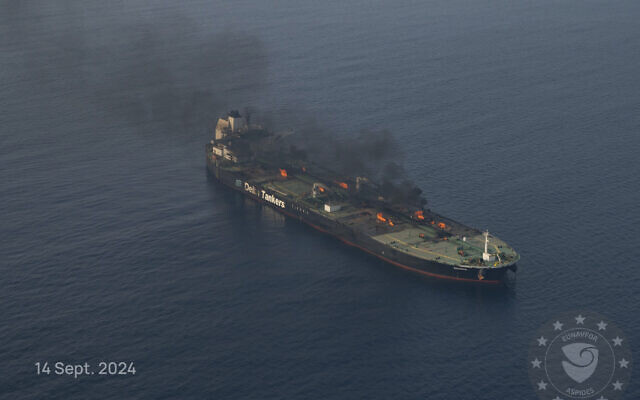Drones and missiles fired from nearby Yemen caused some damage but no injuries to crew on board the products tanker Olympic Spirit (IMO 9327097) on Thursday of last week.
The Liberian-flagged tanker was sailing about 70 nautical miles southwest of the Yemeni port of Hodeida when attacked on 10 October. Olympic Spirit had departed from Jeddah further along the Red Sea coast and was bound for Muscat in Oman where she is due on 15 October.
From reports given the tanker was struck by a single missile or drone on the starboard side of the bridge, causing minor damage according to the British security group, Ambrey.
As the vessel continued on its way it came under further attack some four hours later when another two missiles landed in the sea a short distance from the tanker.
The United Kingdom Maritime Trade Operations (UKMTO) reported the vessel as having some ‘technical issues but remains seaworthy and was continuing its journey.’
Container ship St John
Another ship, the container vessel St John (IMO 9634646), sailing from Mogadishu for Jebel Ali, reportedly also came under attack from a long-range drone late last week.
It is not known if the 168-metre long, 26 metre wide vessel was hit and if so whether any damage resulted. AIS shows the vessel as continuing her voyage from the Somalia port on a heading for Oman and currently underway in the Arabian Sea.
The Houthi movement has claimed responsibility for this attack, calling it a part of its attacks on global shipping associated in some way with the Israelis and their war in Gaza.
To date the Houthis have carried out almost 100 attacks against shipping in the region of the lower Red Sea, Gulf of Aden or the Arabian Sea. Only two vessels have been sunk and four seafarers are known to have lost their lives.
Despite this low ‘success rate’ by the Houthis, the economic cost has been astronomical in terms of the cost to ship owners and operators as well as cargo owners, as ships are forced to navigate the longer route around the Cape of Good Hope.
Also severely affected is the Suez Canal Authority and indeed the country of Egypt, which has lost more than 60% of its canal traffic. Various transshipment ports in the Mediterranean and Red Seas are also hurting.
The expectation is that there will be no quick solution and several major shipping companies have already committed to using the Cape route during 2025.
@Africa Ports & Ships. The original article can be found here.

